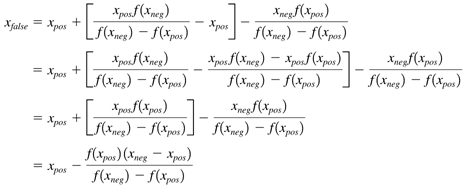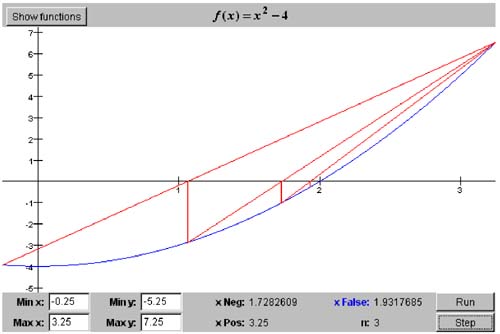5.4 The Regula Falsi Algorithm
5.4 The Regula Falsi Algorithm Obviously, a root-finding algorithm would converge faster if somehow the approximations were to get closer to the root faster. The algorithm of regula falsi (Latin for false position ) attempts to do just that with a smarter algorithm for generating the approximations (false positions ). We'll implement this algorithm in class RegulaFalsiRootFinder. The basic idea is not hard to explain. Like the bisection algorithm, it is a bracketing algorithm that begins with an initial interval containing the root, and each iteration shrinks the interval to trap the root. For each iteration, we have x neg and x pos , the endpoints of interval, and we draw the secant (a line connecting two points on a curve) from the point ( x neg , f ( x neg )) to the point ( x pos , f ( x pos )). Then the new position x false is where the secant crosses the x axis. See Figure 5-1. Figure 5-1. A secant line for the function f ( x ) in the interval [ x pos , x neg ], where f ( x pos ) > 0 and f ( x neg ) < 0. We can compute the value of x false using similar triangles . Because we can cross-multiply and solve for x false : To simplify the right-hand side, we break apart the fraction, add and subtract x pos , and manipulate the terms inside the square brackets: The iteration procedure for the regula falsi algorithm is similar to that for the bisection algorithm. If f ( x false ) < 0, then the root must be in the x pos half of the interval, so the algorithm sets x neg to x false for the next iteration. On the other hand, if f ( x false ) > 0, then the root must be in the x neg half of the interval, so the algorithm sets x pos to x false for the next iteration. If f ( x false ) is 0, or sufficiently close to 0, then the algorithm stops, and the final value of x false is the root it managed to trap. Screen 5-2 is a screen shot of the interactive version of Program 5 C2, which instantiates a RegulaFalsiRootFinder object. Screen 5-2 shows the first three iterations of the regula falsi algorithm applied to the function f ( x ) = x 2 - 4 in the initial interval [-0.25, 3.25]. Notice that the algorithm tends to converge toward the root from one side only. Screen 5-2. The first three iterations of the regula falsi algorithm applied to the function f ( x ) = x 2 - 4 in the initial interval [-0.25, 3.25]. The three secant lines (and the short vertical lines marking the positions of x false ) are superimposed on each other. This screen shot is from the interactive version of Program 5 C2. Listing 5-2a shows the class RegulaFalsiRootFinder , which implements this algorithm. It is very similar to class BisectionRootFinder. Listing 5-2a The class that implements the regula falsi algorithm. package numbercruncher.mathutils; /** * The root finder class that implements the regula falsi algorithm. */ public class RegulaFalsiRootFinder extends RootFinder { private static final int MAX_ITERS = 50; private static final float TOLERANCE = 100*Epsilon.floatValue(); /** x-negative value */ protected float xNeg; /** x-false value */ protected float xFalse = Float.NaN; /** x-positive value */ protected float xPos; /** previous x-false value */ protected float prevXFalse; /** f(xNeg) */ protected float fNeg; /** f(xFalse) */ protected float fFalse = Float.NaN; /** f(xPos) */ protected float fPos; /** * Constructor. * @param function the functions whose roots to find * @param xMin the initial x-value where the function is negative * @param xMax the initial x-value where the function is positive * @throws RootFinder.InvalidIntervalException */ public RegulaFalsiRootFinder(Function function, float xMin, float xMax) throws RootFinder.InvalidIntervalException { super(function, MAX_ITERS); checkInterval(xMin, xMax); float yMin = function.at(xMin); float yMax = function.at(xMax); // Initialize xNeg, fNeg, xPos, and fPos. if (yMin < 0) { xNeg = xMin; xPos = xMax; fNeg = yMin; fPos = yMax; } else { xNeg = xMax; xPos = xMin; fNeg = yMax; fPos = yMin; } } //---------// // Getters // //---------// /** * Return the current value of x-negative. * @return the value */ public float getXNeg() { return xNeg; } /** * Return the current value of x-false. * @return the value */ public float getXFalse() { return xFalse; } /** * Return the current value of x-positive. * @return the value */ public float getXPos() { return xPos; } /** * Return the current value of f(x-negative). * @return the value */ public float getFNeg() { return fNeg; } /** * Return the current value of f(x-false). * @return the value */ public float getFFalse() { return fFalse; } /** * Return the current value of f(x-positive). * @return the value */ public float getFPos() { return fPos; } //----------------------------// // RootFinder method overrides // //----------------------------// /** * Do the regula falsi iteration procedure. * @param n the iteration count */ protected void doIterationProcedure(int n) { if (n == 1) return; // already initialized if (fFalse < 0) { xNeg = xFalse; // the root is in the xPos side fNeg = fFalse; } else { xPos = xFalse; // the root is in the xNeg side fPos = fFalse; } } /** * Compute the next position of x-false. */ protected void computeNextPosition() { prevXFalse = xFalse; xFalse = xPos - fPos*(xNeg - xPos)/(fNeg - fPos); fFalse = function.at(xFalse); } /** * Check the position of x-false. * @throws PositionUnchangedException */ protected void checkPosition() throws RootFinder.PositionUnchangedException { if (xFalse == prevXFalse) { throw new RootFinder.PositionUnchangedException(); } } /** * Indicate whether or not the algorithm has converged. * @return true if converged, else false */ protected boolean hasConverged() { return Math.abs(fFalse) < TOLERANCE; } } The noninteractive version of Program 5 C2 instantiates a RegulaFalsiRootFinder object, and it shows that, for the same function f ( x ) = x 2 - 4 and the same initial interval [-0.25, 3.25], the regula falsi algorithm converges faster than the bisection algorithm. See Listing 5-2b. Listing 5-2b The noninteractive version of Program 5 C2 applies the regula falsi algorithm applied to the function f ( x ) = x 2 - 4 in the initial interval [-0.25, 3.25]. package numbercruncher.program5_2; import numbercruncher.mathutils.Function; import numbercruncher.mathutils.RegulaFalsiRootFinder; import numbercruncher.mathutils.AlignRight; import numbercruncher.rootutils.RootFunctions; /** * PROGRAM 5C2: Regula Falsi Algorithm * * Demonstrate the Regula Falsi Algorithm on a function. */ public class RegulaFalsiAlgorithm { /** * Main program. * @param args the array of runtime arguments */ public static void main(String args[]) { try { RegulaFalsiRootFinder finder = new RegulaFalsiRootFinder(RootFunctions.function("x^2 - 4"), -0.25f, 3.25f); AlignRight ar = new AlignRight(); ar.print("n", 2); ar.print("xNeg", 11); ar.print("f(xNeg)", 15); ar.print("xFalse", 11); ar.print("f(xFalse)", 15); ar.print("xPos", 6); ar.print("f(xPos)", 9); ar.underline(); // Loop until convergence or failure. boolean converged; do { converged = finder.step(); ar.print(finder.getIterationCount(), 2); ar.print(finder.getXNeg(), 11); ar.print(finder.getFNeg(), 15); ar.print(finder.getXFalse(), 11); ar.print(finder.getFFalse(), 15); ar.print(finder.getXPos(), 6); ar.print(finder.getFPos(), 9); ar.println(); } while (!converged); System.out.println("\nSuccess! Root = " + finder.getXFalse()); } catch(Exception ex) { System.out.println("***** Error: " + ex); } } } Output: n xNeg f(xNeg) xFalse f(xFalse) xPos f(xPos) --------------------------------------------------------------------- 1 -0.25 -3.9375 1.0625 -2.8710938 3.25 6.5625 2 1.0625 -2.8710938 1.7282609 -1.0131145 3.25 6.5625 3 1.7282609 -1.0131145 1.9317685 -0.26827025 3.25 6.5625 4 1.9317685 -0.26827025 1.9835405 -0.06556702 3.25 6.5625 5 1.9835405 -0.06556702 1.9960688 -0.015709162 3.25 6.5625 6 1.9960688 -0.015709162 1.9990634 -0.0037455559 3.25 6.5625 7 1.9990634 -0.0037455559 1.999777 -8.921623E-4 3.25 6.5625 8 1.999777 -8.921623E-4 1.9999468 -2.1266937E-4 3.25 6.5625 9 1.9999468 -2.1266937E-4 1.9999874 -5.054474E-5 3.25 6.5625 10 1.9999874 -5.054474E-5 1.999997 -1.1920929E-5 3.25 6.5625 11 1.999997 -1.1920929E-5 1.9999992 -3.33786E-6 3.25 6.5625 Success! Root = 1.9999992 The output shows that the value of x pos never changed the algorithm converged to the root from one side only. |
| |
| Top |
EAN: 2147483647
Pages: 141




